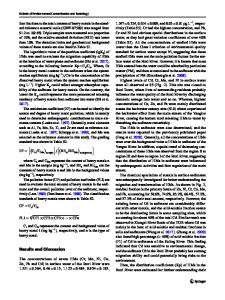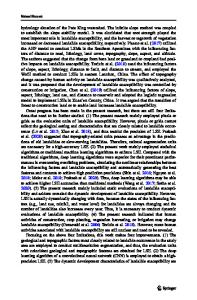Effects of moss-dominated biocrusts on soil detachment by overland flow in the Three Gorges Reservoir Area of China
- PDF / 1,155,144 Bytes
- 14 Pages / 595.22 x 842 pts (A4) Page_size
- 104 Downloads / 346 Views
e-mail: [email protected]
http://jms.imde.ac.cn
Effects of moss-dominated biocrusts on soil detachment by overland flow in the Three Gorges Reservoir Area of China ZHANG Guan-hua1,2* DING Wen-feng1,2 PU Jian1,2
http://orcid.org/0000-0002-4366-788X;
e-mail: [email protected]
http://orcid.org/0000-0001-6011-7495; e-mail: [email protected]
http://orcid.org/0000-0001-5369-1536; e-mail: [email protected] http://orcid.org/0000-0001-5888-7351; e-mail: [email protected]
LI Jian-ming1,2 QIAN Feng1,2
http://orcid.org/0000-0003-3859-9613; e-mail: [email protected]
SUN Bao-yang1,2
http://orcid.org/0000-0002-5139-5992; e-mail: [email protected]
* Corresponding author 1 Soil and Water Conservation Department, Changjiang River Scientific Research Institute, Wuhan 430010, China 2 Research Center on Mountain Torrent & Geologic Disaster Prevention of Ministry of Water Resources, Wuhan 430010, China Citation: Zhang GH, Ding WF, Pu J, et al. (2020) Effects of moss-dominated biocrusts on soil detachment by overland flow in the Three Gorges Reservoir Area of China. Journal of Mountain Science 17(10). https://doi.org/10.1007/s11629-0206200-6
© Science Press, Institute of Mountain Hazards and Environment, CAS and Springer-Verlag GmbH Germany, part of Springer Nature 2020
Abstract: Biological soil crusts (biocrusts) are important landscape components that exist in various climates and habitats. The roles of biocrusts in numerous soil processes have been predominantly recognized in many dryland regions worldwide. However, little is known about their effects on soil detachment process by overland flow, especially in humid climates. This study quantified the effects of moss-dominated biocrusts on soil detachment capacity (Dc) and soil erosion resistance to flowing water in the Three Gorges Reservoir Area which holds a subtropical humid climate. Potential factors driving soil detachment variation and their influencing mechanism were analyzed and elucidated. We designed five levels of coverage treatments (1%–20%, 20%–40%, 40%–60%, 60%–80%, and 80%–100%) and a nearby bare land as control in a mossdominated site. Undisturbed soil samples were taken and subjected to water flow scouring in a hydraulic flume under six shear stresses ranging from 4.89 to 17.99 Pa. The results indicated that mean Dc of mossReceived: 14-May-2020 Revised: 07-Jul-2020 Accepted: 18-Aug-2020
2418
covered soil varied from 0.008 to 0.081 kg m-2 s-1, which was 1.9 to 21.0 times lower than that of bare soil (0.160 kg m-2 s-1). Rill erodibility (Kr) of mosscovered soil ranged from 0.0095 to 0.0009 s m-1, which was 2 to 20 times lower than that of bare soil (0.0187 s m-1). Both relative soil detachment rate and Kr showed an exponential decay with increasing moss coverage, whereas the critical shear stress (τc) for different moss coverage levels did not differ significantly. Moss coverage, soil cohesion, and sand content were key factors affecting Dc, while moss coverage and soil bulk density were key factors affecting Kr. A power function of flow shear stress
Data Loading...











